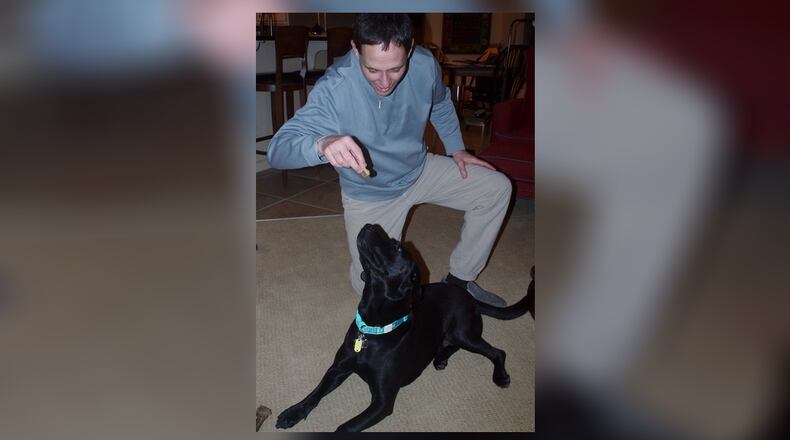» Karin Spicer on letting a dog sleep in owners' bed
First by Ed, Teddy’s human dad and fearless leader. Ed’s usual greeting, “Who’s my good boy?”
Teddy’s response is to wiggle and roll over for tummy rubs and praise.
When Ed stopped, Teddy wiggled over to Jordan, Teddy’s adoring big sis, for more of the same.
Finally, the pooch sauntered over to me, his human mom. The last human of importance in Teddy’s pack.
Teddy got a tummy rub and a heap of praise. Then a piece of cheddar cheese. I’m angling for a higher position in his pack.
Teddy loves tummy rubs and praise.
If given the choice, the lab will take a tummy rub and a “You’re a good boy, Teddy” over a game of tug-of-war every time.
Teddy also loves treats.
You only have to say, “Teddy, treat,” once and he comes running.
So what does the pooch like more? Tummy rubs or food treats? That’s a big debate in our family.
Researchers at Emory University in Atlanta wanted to see if dogs value human company more than food rewards.
The scientists did this by conducting brain scans of 15 dogs when given objects in combination with rewards of praise or food.
The majority of dogs, 13 out of 15, preferred human interaction or praise over the food.
So back to the question, “What does Teddy like more?” Praise and tummy rubs or food treats?
Ed and Jordan are leaning toward tummy rubs and praise, with food treats coming in a close second.
I believe a big hunk of cheese or piece of chicken might persuade Teddy to turn away from a potential tummy rub.
Since we want positive behaviors from Teddy, we heap the praise, tummy rubs and treats on him.
When asked about the Emory study, Savannah Hoying, a local veterinarian, said that individual dogs have individual needs. Praise or food treats are dog specific.
In other words, it all depends on how a dog was raised as well as how he’s wired.
It’s no different with humans. Each of us have different social and physical needs based on our own upbringing and how we are wired.
RELATED
Remember when you brought home a good grade on a paper?
What kind of response did you get? Verbal praise? Your paper hung on the refrigerator? Cookies and milk?
More importantly, how did it make you feel?
Did you expect to receive verbal praise or your paper ceremoniously hung on the fridge when you brought home your next good grade? Food rewards?
If you were lucky, all three.
Dogs are no different.
Once they receive positive reinforcement for a behavior, whether it be in the form of verbal praise or food treat, they’re likely to repeat it.
After executing a positive behavior, Teddy excitedly looks for his rewards.
First, tummy rubs and praises of “Good Boy!”
Then a few tasty treats. Usually cheddar cheese cubes.
Teddy excitement over his rewards is fun to watch.
His tail wagging furiously as his tummy is rubbed. His prancing over to the fridge for a cheese cube.
I just wish cheese cubes were an acceptable reward for a husband’s “good behaviors.”
Karin Spicer, a magazine writer, has been entertaining families for more than 20 years. She lives in Bellbrook with her family and two furry animals all who provide inspiration for her work. She can be reached at spicerkarin@gmail.com.
Positive reinforcement tips
1. The reward must occur right after the behavior.
2. Keep commands short and simple.
3. Everyone in the family should give the same command and reward.
About the Author
